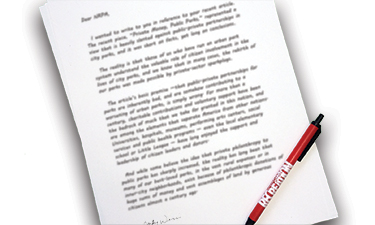 [Ed. Note: The below letter was excerpted from an email written to Arnie Biondo, author of “Ideas to Make Golf More Popular”.]
[Ed. Note: The below letter was excerpted from an email written to Arnie Biondo, author of “Ideas to Make Golf More Popular”.]
I would like to respond to your article in the August issue of Parks & Recreation. At age 60, I have been a golfer most of my life, and my wife and I bought the local municipal-style 18-hole golf course in 1999.
The issues you mentioned with the golf industry were spot-on, but some of your suggestions appear to be from someone who is either not a golfer or not familiar with the golf industry. What we have to be careful of is losing our customers who are traditionalists by doing nontraditional things. You run the risk of sending away the customers who make up 90 percent of your revenue to gain a few who want to spend nothing. You do make a few good points, so I would like to address some of these points individually if I might.
“Offer some freebies.”
I wish I could buy a golf shirt for $11, as you suggested. Our cost, for a minimum order of 72, is $19 for medium quality. Additionally, most golfers with even a moderate skill level would be insulted if you offered them a 42-cent ball. My cost for a dozen of the lowest-quality balls that I would consider selling in my shop would be $12.
“Charge by the hour, not by the round.”
Sounds plausible for something like a tennis or raquetball court, but what happens if the hour runs out and the golfers are on the other side of the course? They have to dodge flying golf balls to make it back to the shop, if they even come in. What if they get behind a group that plays slow and they don’t get as many holes in for their hour as they did last week?
“Put a larger cup on each green.”
Golf greens are a fine line between agriculture and science, cut at between 1/8 and 3/16 inches with specialized equipment. The holes are set with special equipment as well. Moving the hole to a new location every day is required. Now moving two holes and leveling out the new big hole is logistically impractical.
“Build larger greens and place multiple cups on the green.”
Again, bigger greens cost more money. They need to be cut each day, require tons of water to be kept alive and require the majority of the annual chemical budget just in order to fight disease, which will kill the grass overnight if not treated correctly and at the right time. More costs mean higher fees.
“Provide decent loaner clubs at no charge.”
I am all about getting new people into the game, but they are also the ones who do the most damage to the course. If a chunk is taken out of the center of the green, be it by mistake or anger, it takes three weeks for that to heal. Most damage done to the golf course is by people who have little respect for the course or those who play behind them. To have four loaner sets on my golf course on any one day would make me a nervous wreck, let alone 20.
“Adopt a liberal interpretation of the rules, or write your own house rules.”
No one should feel that they are bound by the Royal and Ancient if you play for fun. Establishing a handicap in order to play in tournaments or tournament play is different. Most just play for fun, though.
“Remove some sand traps.”
What about the golfer who does his best to avoid the hazards? He likes the challenge and would be disappointed to play a course that filled in bunkers, which also define the hole and give you an aiming point. With a little practice, the bunker shot is one of the easiest in the game — that’s why the pros aim there on par 5s.
Clyde Scott, Owner/Operator, Eagle Pines Golf Club, Mooresville, Indiana

